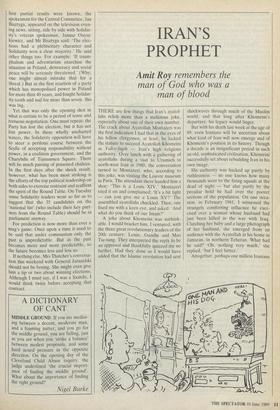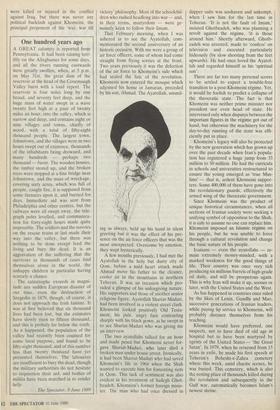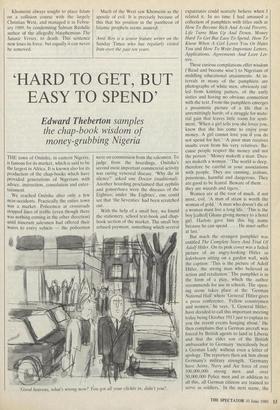IRAN'S PROPHET
Amit Roy remembers the
man of God who was a man of blood
THERE are few things that Iran's ayatol- lahs relish more than a malicious joke, especially about one of their own number. The crack about Ayatollah Montazeri was the first indication I had that in the eyes of his fellow clergymen, at least, he lacked the stature to succeed Ayatollah Khomeini as Vali-e-fagih — Iran's high religious authority. Over lunch with a gathering of ayatollahs during a visit to Urumieh in north-west Iran in 1980, the conversation turned to Montazeri, who, according to this joke, was visiting the Louvre museum in Paris. The attendant there handed him a shoe: 'This is a Louis XIV.' Montazeri tried it on and complained: 'It's a bit tight — can you give me a Louis XV?' The assembled ayatollahs chuckled. Then., one fixed me with a keen eye, and asked: 'And what do you think of our Imam?'
A joke about Khomeini was unthink- able. I would bracket him, I ventured, with the three great revolutionary leaders of the 20th century: Lenin, Gandhi and Mao Tse-tung. They interpreted the reply to be an approval and thankfully quizzed me no further. Had they done so I would have added that the Islamic revolution had sent shockwaves through much of the Muslim world, and that long after Khomeini's departure, his legacy would linger.
But with his death last week at the age of 89, even Iranians will be uncertain about what kind of Iran will now emerge and of Khomeini's position in its history. Though a decade is an insignificant period in such an old, sophisticated civilisation, Khomeini successfully set about rebuilding Iran in his own image.
His authority was backed up partly by ruthlessness — no one knows how many thousands went to the firing squads at the dead of night — but also partly by the peculiar hold he had over the poorer sections of the population. On one occa- sion, in February 1981, I witnessed the strangely comforting influence he exer- cised over a woman whose husband had just been killed in the war with Iraq. Clutching her baby and a large photograph of her husband, she emerged from an audience with the Ayatollah at his home in Jamaran, in northern Teheran. What had he said? 'Oh, nothing very much,' she replied, 'but I feel better.'
Altogether, perhaps one million Iranians were killed or injured in the conflict against Iraq, but there was never any political backlash against Khomeini, the principal proponent of the 'war, war till victory' philosophy. Most of the schoolchil- dren who rushed headlong into war — and, in their terms, martyrdom — were ge- nuinely keen to follow their Imam.
That February morning, when I was ushered in to see the Ayatollah, com- memorated the second anniversary of an historic occasion. With me were a group of air force officers, some of whom had come straight from flying sorties at the front. Two years previously it was the defection of the air force to Khomeini's side which had sealed the fate of the revolution. Khomeini now entered the mosque which adjoined his home in Jamaran, preceded by his son, Ahmad. The Ayatollah, unsmil- ing as always, held up his hand in silent greeting but it was the effect of his pre- sence on the air force officers that was the most unexpected. Overcome by emotion, they wept hysterically.
A few months previously, I had met the Ayatollah in the holy but dusty city of Qom, before a mild heart attack made Ahmad move his father to the cleaner, cooler air in the mountains in northern Teheran. It was an occasion which pro- vided a glimpse of his unforgiving nature. His supporters and those of another senior religious figure, Ayatollah Shariat-Madari, had been involved in a violent street clash. Khomeini looked positively Old Testa- ment, his pale, angry face contrasting sharply with his black gown, as he swept in to see Shariat-Madari who was giving me an interview.
The two ayatollahs talked for an hour and made peace but Khomeini never for- gave Shariat-Madari, who later died a broken man under house arrest. Ironically, it had been Shariat-Madari who had saved Khomeini's life in 1964 when the Shah wanted to execute him for fomenting riots in Qom. This lack of sentiment was also evident in his treatment of Sadegh Ghot- bzadeh, Khomeini's former foreign minis- ter. The man who had once dressed in dapper suits was unshaven and unkempt, when I saw him for the last time in Teheran. 'It is not the fault of Imam,' insisted Ghotbzadeh, who was planning a revolt against the regime, 'it is those around him.' Shortly afterward, Ghotb- zadeh was arrested, made to 'confess' on television and executed particularly hideously (by slow shooting from the feet upwards). He had once loved the Ayatol- lah and regarded himself as his 'spiritual son'.
There are far too many personal scores to be settled to expect a trouble-free transition to a post-Khomeini regime. Yet, it would be foolish to predict a collapse of the theocratic state. The fact is that Khomeini was neither prime minister nor president nor even head of state. He intervened only when disputes between the important figures in the regime got out of hand, but otherwise the machinery for the day-to-day running of the state was effi- ciently put in place.
Khomeini's legacy will also be protected by the new generation which has grown up over the past decade when Iran's popula- tion has registered a huge jump from 33 million to 50 million. He had the curricula in schools and universities restructured to ensure the young emerged as 'true Mus- lims' — that is, ardent Khomeini suppor- ters. Some 400,000 of them have gone into the revolutionary guards, effectively the armed wing of the theocratic government.
Since Khomeini was the product of unique historical circumstances, when all sections of Iranian society were seeking a unifying symbol of opposition to the Shah, it is safe to assume no one can replace him. Khomeini imposed an Islamic regime on his people, but he was unable to force through a cultural revolution and change the basic nature of his people.
Iranians — even the ayatollahs — re- main extremely money-minded, with a marked weakness for the good things of life. Their country was once very rich producing six millions barrels of high-grade oil daily, and will be prosperous again. This is why Iran will make it up, sooner or later, with the United States and the West.
As has happened in countries once ruled by the likes of Lenin, Gandhi and Mao, successive generations of Iranian leaders, while paying lip service to Khomeini, will probably distance themselves from his teaching.
Khomeini would have preferred, one suspects, not to have died of old age in hospital but to have been martyred by agents of the United States— 'the Great Satan'. In 1979, when he returned from 15 years in exile, he made his first speech at Teheran's Behesht-e-Zahra cemetery where this week, amid chaotic scenes, he was buried. This cemetery, which is also the resting place of thousands killed during the revolution and subsequently in the Gulf war, automatically becomes Islam's newest shrine. Khomeini always sought to place Islam on a collision course with the largely Christian West, and managed it in Febru- ary 1989, by condemning Salman Rushdie author of the allegedly blasphemous The Satanic Verses, to death. This sentence now loses its force, but equally it can never be removed.
Much of the West saw Khomeini as the apostle of evil. It is precisely because of this that his position in the pantheon of Islamic prophets seems assured.
Anzit Roy is a senior feature writer on the Sunday Times who has regularly visited Iran over the past ten years.




























































 Previous page
Previous page